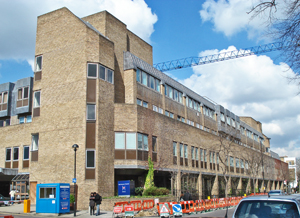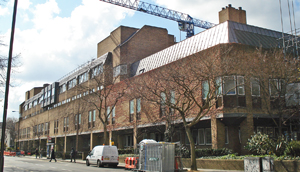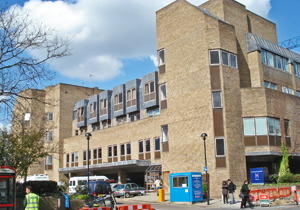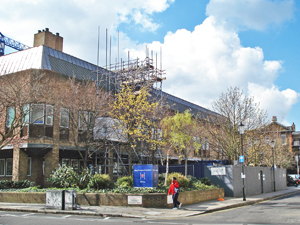St Luke's Hospital
Sydney Street, Chelsea, SW3 6NP
Medical
dates:
Medical
character:
General. Later, geriatric
In 1872 a separate infirmary for
the Chelsea workhouse was built along Sydney Street, which itself had
been built in 1843 and extended in 1860. The Chelsea Infirmary
lay to the north of the workhouse in Britten Street, and was connected
to it by tunnels under the road.
In 1881 the Local Government Board approved the purchase of a plot of land in Britten Street to enlarge the workhouse, and another block was added in 1883. In 1885 another ward block was added on Cale Street. A Nursing School opened in 1886 and staff accommodation was built the same year at the corner of Cale and Sydney Streets.
In 1902 the Chelsea Infirmary Nurses' League was founded by the Matron, Miss Eleanor C. Barton. As well as nursing matters, the League took an interest in subjects of general importance. Between 1903 and 1905 two further ward blocks were added to the 1883 blocks to house aged and infirm women at a cost of over £41,000. By this time the Infirmary had 420 beds.
At the beginning of WW1 in 1914 some 50 beds were allocated to Belgian refugees.
By 1919 the Infirmary had 423 beds.
In 1921 the original block was extended eastward to house a reception ward and additional accommodation. The sick and infirm were also housed in the workhouse.
In 1930, when the Boards of Guardians had been abolished, the LCC took over control of the workhouse and its infirmary. The workhouse was renamed the Chelsea Institution, while the infirmary became St Luke's Hospital. Both were administered by the Hospital.
By 1938 the Hospital had 308 beds for general medical and surgical patients, and 82 special beds, including 60 for patients with TB. It was the main acute general hospital for Chelsea.
At the outbreak of WW2 in 1939 the Institution and Hospital joined the Emergency Medical Service. In 1941 the Hospital was hit by a large bomb, rendering it unsuitable for use as a general hospital. The kitchen complex was destroyed and the front entrance of the Hospital completely cut off from the rest of the buildings. The operating theatre block was damaged, as were the ward blocks, reducing the bed complement to 230.
In 1948 the Institution and Hospital joined the NHS as St Luke's Hospital, under the control of the Chelsea and Kensington Hospital Management Committee, part of the South West Metropolitan Regional Hospital Board. The Hospital consisted of two 4-storey ward blocks with basements (the upper levels of the ward blocks were connected to each other by iron fire bridges), an administration building, a Nurses' Home, dental laboratory, a dispensary, a mortuary and a boiler house. The wards were overcrowded, with 34 beds, one bathroom, 2 WCs, and a Day Room in each. One ward block had no lift, so that patients (dead or alive) had to be taken, via the iron bridge, into the block with a lift. Half of the old laundry had been made into a kitchen, while the other half was used as a sorting office. The Hospital laundry was sent to the Regional laundry at Carshalton.
In July 1948 the Management Committee of the Cancer Hospital had pressed the Regional Hospital Board for the use of St Luke's as a research facility, but eventually gave up the notion and went elsewhere.
In 1950 the Hospital had 390 beds for the chronically ill, of which 238 were open.
In 1951 the Regional Hospital Board, having fended off the claims of the Cancer Hospital, decided to transfer two of the top floor wards to the nearby Chelsea Hospital for Women to use as a Pathology Laboratory (the Hospitals were separated by a brick wall running from north to south from Cale Street to Britten Street). After the transfer, the Hospital had 264 beds.
In 1953 a Rehabilitation Unit was established. The Hospital had 99.5% bed occupancy, with a nursing staff of 150.
By 1971 the Hospital had 202 beds for geriatric patients.
It closed in 1974.
Present status (April 2008)
The Royal Brompton Hospital took over the site once the plan to build several specialist hospitals on the site of the St Luke's Hospital and Chelsea Hospital for Women failed to materialise after over ten years of discussion.
The Hospital and workhouse buildings have been demolished. The site of the Hospital is now occupied by the Sydney Wing of the Royal Brompton Hospital, which opened in 1991 for the treatment of, and research into, heart and lung conditions.
In 1881 the Local Government Board approved the purchase of a plot of land in Britten Street to enlarge the workhouse, and another block was added in 1883. In 1885 another ward block was added on Cale Street. A Nursing School opened in 1886 and staff accommodation was built the same year at the corner of Cale and Sydney Streets.
In 1902 the Chelsea Infirmary Nurses' League was founded by the Matron, Miss Eleanor C. Barton. As well as nursing matters, the League took an interest in subjects of general importance. Between 1903 and 1905 two further ward blocks were added to the 1883 blocks to house aged and infirm women at a cost of over £41,000. By this time the Infirmary had 420 beds.
At the beginning of WW1 in 1914 some 50 beds were allocated to Belgian refugees.
By 1919 the Infirmary had 423 beds.
In 1921 the original block was extended eastward to house a reception ward and additional accommodation. The sick and infirm were also housed in the workhouse.
In 1930, when the Boards of Guardians had been abolished, the LCC took over control of the workhouse and its infirmary. The workhouse was renamed the Chelsea Institution, while the infirmary became St Luke's Hospital. Both were administered by the Hospital.
By 1938 the Hospital had 308 beds for general medical and surgical patients, and 82 special beds, including 60 for patients with TB. It was the main acute general hospital for Chelsea.
At the outbreak of WW2 in 1939 the Institution and Hospital joined the Emergency Medical Service. In 1941 the Hospital was hit by a large bomb, rendering it unsuitable for use as a general hospital. The kitchen complex was destroyed and the front entrance of the Hospital completely cut off from the rest of the buildings. The operating theatre block was damaged, as were the ward blocks, reducing the bed complement to 230.
In 1948 the Institution and Hospital joined the NHS as St Luke's Hospital, under the control of the Chelsea and Kensington Hospital Management Committee, part of the South West Metropolitan Regional Hospital Board. The Hospital consisted of two 4-storey ward blocks with basements (the upper levels of the ward blocks were connected to each other by iron fire bridges), an administration building, a Nurses' Home, dental laboratory, a dispensary, a mortuary and a boiler house. The wards were overcrowded, with 34 beds, one bathroom, 2 WCs, and a Day Room in each. One ward block had no lift, so that patients (dead or alive) had to be taken, via the iron bridge, into the block with a lift. Half of the old laundry had been made into a kitchen, while the other half was used as a sorting office. The Hospital laundry was sent to the Regional laundry at Carshalton.
In July 1948 the Management Committee of the Cancer Hospital had pressed the Regional Hospital Board for the use of St Luke's as a research facility, but eventually gave up the notion and went elsewhere.
In 1950 the Hospital had 390 beds for the chronically ill, of which 238 were open.
In 1951 the Regional Hospital Board, having fended off the claims of the Cancer Hospital, decided to transfer two of the top floor wards to the nearby Chelsea Hospital for Women to use as a Pathology Laboratory (the Hospitals were separated by a brick wall running from north to south from Cale Street to Britten Street). After the transfer, the Hospital had 264 beds.
In 1953 a Rehabilitation Unit was established. The Hospital had 99.5% bed occupancy, with a nursing staff of 150.
By 1971 the Hospital had 202 beds for geriatric patients.
It closed in 1974.
Present status (April 2008)
The Royal Brompton Hospital took over the site once the plan to build several specialist hospitals on the site of the St Luke's Hospital and Chelsea Hospital for Women failed to materialise after over ten years of discussion.
The Hospital and workhouse buildings have been demolished. The site of the Hospital is now occupied by the Sydney Wing of the Royal Brompton Hospital, which opened in 1991 for the treatment of, and research into, heart and lung conditions.

The eastern elevation of the Sydney Wing along Sydney Street from the south (above) and the north (below).


The southern elevation and main entrance in Britten Street (above) and the northern side in Cale Street (below).

(Author unstated) 1905 Nurses of note. Miss Eleanor C. Barton. British Journal of Nursing, 28th January, 95.
(Author unstated) 1914 Nursing echoes. British journal of Nursing, 17th October, 310.
www.aim25.ac.uk
www.allposters.com
www.architecture.com
www.british-history.ac.uk (1)
www.british-history.ac.uk (2)
www.flickr.com
www.theyworkforyou.com
www.workhouses.org.uk
Return to home page